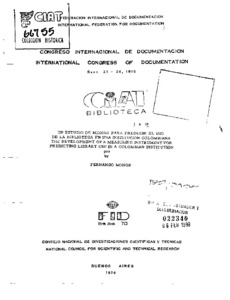Un estudio de medida para predecir el uso de la biblioteca en una institución colombiana = The development of a measuring instrument for predicting library use in a Colombian institution
Fifty seven scientists of the Instituto Colombiano de la Reforma Agraria (INCORA) performing research and development functions were randomly chosen to investigate some of the correlates of the Library Use dimension. Library Use was operationalized into two dependent variables, Percent Work Time Devoted to INCORA`s Library Consultation, and Total Library Use (which measured the use of any library at any time). Twelve independent variables were used as predictors, the ones showing a higher degree of association with either dependent variables being, the type of decision involved ("genuine", habitual, or impulsive), whether library use was perceived as criterion for promotion, easiness of access to the needed information, reward orientation (practical or idealistic), and importance attached to the use of the library. The article illustrates the use of configurational analysis for prediction. This type of analysis works by ranking the various predictors from high to low in terms of their association to the dependent variable. Variables are dichotomized (or trichotomized at mos.) and the groups resulting from cross-tabulation are considered independent sub-samples. Accuracy of prediction, then, is checked against actual results obtained for the dependent variable. Cases considered "explained" by one predictor are eliminated from the analysis, and the remaining "unexplained" cases go through the same type of analysis using the next highest associated predictor. A terminal configuration is that which meets a certain pre-established probability-of-accurate-prediction level. Based on this analysis, measuring instruments were developed for the prediction of both dependent variables, reaching cumulative accuracy levels of .807 and .824

